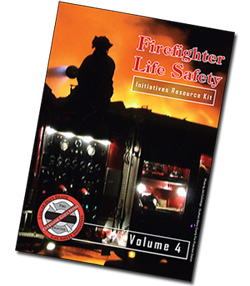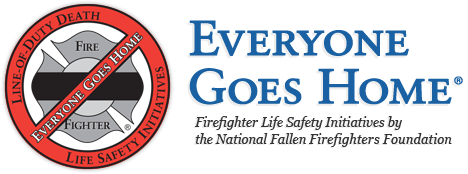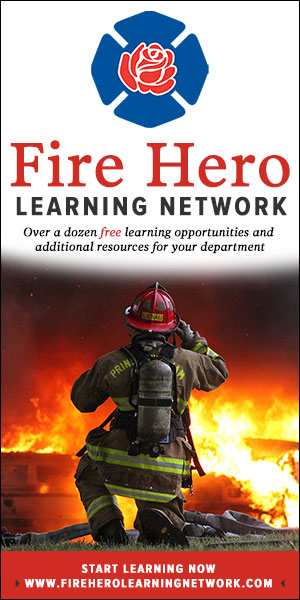
The nation’s fire service is now working to confront the biggest challenge in its history – to change the life safety culture of our fire departments. The fire rescue service in this country has always stepped up to meet the ever increasing challenges confronting them, whether adding services in order to better address the needs of the community, or creating new ways to overcome shrinking budgets while still delivering essential services to those who rely on our protection each day. The challenge to prevent (whenever possible) firefighter line-of-duty deaths is testing the very core of our culture. It will ultimately shape the success of future generations in eliminating these unnecessary deaths.
Over the last 10 years, according to the United States Fire Administration, there have been 1,090 firefighter deaths and nearly 822,000 injuries. The leading causes of death have been heart attacks and strokes (47%), followed by deaths from crashes responding to or returning from incidents (25%). The most unfortunate thing that these statistics show the fire service is that these numbers are predictable, and thus, in many cases, preventable. The lessons that we learn from these tragic incidents serve the fire service best if they are used as the basis of preventing future deaths.
The National Fallen Firefighters Foundation continues its primary mission in developing effective tools that will work as a catalyst in reducing firefighter line-of-duty deaths across the country. The “16 Firefighter Life Safety Initiatives,” created in 2004, were developed for the specific purpose of significantly reducing firefighter line-of-duty deaths by identifying common objectives for all fire departments that, if met, could dramatically decrease the number of preventable firefighter deaths and injuries.
This Firefighter Life Safety Initiatives Resource Kit Volume 4 is aimed at providing specific tools for departments to use in promoting and advocating cultural change within their organization as it relates to safety, leadership, managing risk, accountability and personal responsibility. By design, this resource kit can be implemented at any level in the organization as well as utilized as an educational tool down to the company level in any department. The measurable effectiveness of these resources, just as in any tool, is reliant upon the commitment to adapt and apply these in our responses each day.
The time for change is now, and every firefighter shares in taking responsibility not only for themselves, but for those they work alongside of each day. There has never been a more noble cause, a more important mission, nor a more difficult challenge, than having the courage to change the safety culture of the fire service. Simply put, preventable firefighter deaths are unacceptable.
Have the courage to stand for change, make the difference
each and every shift so that – Everyone Goes Home!
Watch and Download Videos
Download these Videos from our Vimeo album
Download Additional Training Material
The Mayday
The Mayday – “Are you ready?”
Kevin Sehlmeyer, Chief of Training, Grand Rapids Fire Department (MI)
Reading Smoke
» Reading Smoke: The First Step in Safe Decisions
Dave Dodson, Battalion Chief (Ret.), Loveland Fire & Rescue (CO)
Seatbelts Safety
» Seatbelt Safety Powerpoint
» Seatbelt Teaching Outline (MS Word)
» International Seabelt Pledge
» NIOSH LODD Reports 2005-01 | 2005-27 | 2005-28 | 2005-35 | 2006-06 | 2006-25
Fitness for Survival
Dan Media, Chief of Training, Sterling Heights Fire Department (MI)
» Activity Chart (PDF)
» AHA Cholesterol Sheet (PDF)
» AHA Circulation-hrt ds and Stroke Stats – 2006 Update (PDF)
» AJH-BP in Emergency Responders (PDF)
» BMI Table (PDF)
» CDC Health in the U.S. – 2007 Trends (PDF)
» The Practical Guide – Identification, Evaluation, and Treatment of Overweight and Obesity in Adults (PDF)
» Obesity Chart (.gif)
» Obesity and Cardiovascular Disease Risk Factors in Firefighters – 2004 (PDF)
» Occupational Medicine – Obesity in Firefighters (PDF)
» Training Exercise Manual (Powerpoint)
» Firefighter Fitness SOG Draft (MS Word)
» Firefighter Fitness Best Practices (MS Word)
» Firefighter Fitness Outline (MS Word)
» Firefighter Fitness Websites (MS Word)
» CDC Eating Away from Home Food (PDF)
» CDC Eating Fruit and Vegetables to Lose Weight (PDF)
» CDC Portion Size Research (PDF)
» CDC Sweetened Beverages (PDF)
» CDC Fruit and Vegetables (Powerpoint)
» NIOSH LODD Report- Heart Attack 2007-22 (PDF)
» NIOSH LODD Report- Heart Attack 2007-24 (PDF)
» NIOSH LODD Report- Heart Attack 2007-15 (PDF)
» NIOSH LODD Report- Heart Attack 2008-16 (PDF)
» NIOSH LODD Report- Heart Attack 2007-21 (PDF)
» NIOSH LODD Report- Heart Attack 2007-38 (PDF)
» FireFightingNews.com: Scappoose Firefighter Killed By Heart Attack After Fighting Fire (PDF)
» NIOSH LODD Report- Heart Attack 2007-23 (PDF)
» Provisional Report On-Duty Firefighter Fatalities in the United States (PDF)
» Firefighters and on-duty deaths from coronary heart disease: a case control study (PDF)
» Excessive Heat Events Guidebook (PDF)
» Firefighter Fatalities – 10 Year View (Excel)
» Firefighter Fatalities in the US – 2007
» Firefighter Fatalities 2009 (PDF)
» Guide to Clinical Prevention (PDF)
» IAFF Fatality Prevention (PDF)
» NEJM Editorial (PDF)
» NEJM: Firefighter and Cardiac Death (PDF)
» NIOSH Alert 2007 (PDF)
» NIOSH: Preventing Firefighter Fatalities Due to Heart Attacks & Other Sudden Cardiovascular Events (PDF)
» USFA: Health and Wellness 2009 (PDF)
RIT: Preparing to Make a Difference
Matt Ratliff, Firefighter/Medic, Sterling Heights Fire Department (MI)
» Rapid Intervention Teams (Powerpoint)
» Job Aid RIT (MS Word)
» RIT Lesson Plan (MS Word)
» RIT Objectives (MS Word)
» RIT SOG Example 1 (MS Word)
» RIT SOG Example 2 (MS Word)
» NIOSH LODD Report – 2007-16 (PDF)
» NIOSH LODD Report – 2007-29 (PDF)
» NIOSH LODD Report – 2008-06 (PDF)
High Visibility Safety Apparel for Roadway Incidents – New Standard on High Visibility Safety Vests for Responders
Courtesy of the Cumberland Valley Volunteer Firemen’s Association and ResponderSafety.com
» High Visibility Safety Apparel for Roadway Incidents (Powerpoint)
» Emergency Responders: Traffic Management (PDF)
» EMS/Fire Incident Safety Poster (PDF)
» Federal Highway Letter (PDF)
» Federal Rule on High Visibility Garments (PDF)
» High Visibility Vests/Model Vest SOG (MS Word)
» National Unified Goal for Traffic Incident Management (PDF)
» Safe Positioning SOG (MS Word)
» Traffic Incident Management Systems (USFA and DOT) (PDF)
» Vest Push Card (PDF)
Fire Service Pre-Planning – Before We Respond
Peter Vlahos, Lieutenant, Bloomfield Twp. Fire Department (MI)
» Pre-Incident Planning (Powerpoint)
» Firefighter Fatality Investigative Report – Sofa Super Store Fire (Charleston, SC) (PDF)
» Fallen Firefighter Website References (MS Word)
» Pre-Incident Survey Checklist (MS Word)
» NIOSH LODD Report – 2006-07 (PDF)
» NIOSH LODD Report – 2007-01 (PDF)
» Pre-Incident Plan Instructor Guide (PDF)
Risk Based Response – Command for Safety
Sean Decrane, Battalion Chief, Columbus Fire Department (OH)
» Dynamic Risk Management – Best Practices (MS Word)
» Dynamic Risk Management – Checklist (MS Word)
» Risk Versus Reward (Powerpoint)
Building Construction Hazards for Today’s Fire Service
Mike O’Brian, Fire Marshal, Brighton Area Fire Department (MI)
» Building Construction Hazards (Powerpoint)
» Facilitator Teaching Outline (MS Word)
» Construction Hazards Checklist (MS Word)
» NIOSH LODD Report – 2007-07 (PDF)
» NIOSH LODD Report – 2007-08 (PDF)
» NIOSH LODD Report – 2008-06 (PDF)
Additional Resources from Everyone Goes Home®, USFA, NIOSH, and NFPA
» NIOSH Alert – Fire Damaged Floors (PDF)
» NIOSH Structural Collapse Study (PDF)
» NIOSH Truss Guide (PDF)
» National Fallen Firefighters Foundation
» Everyone Goes Home® Program
» Department of Homeland Security


